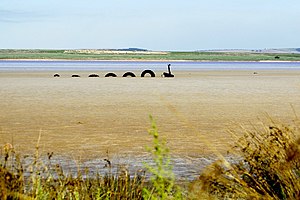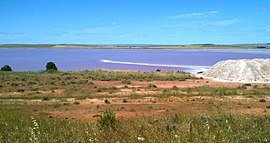Lake Bumbunga
Lake Bumbunga is a salt lake located in South Australia's Mid North between the town of Lochiel and the farming locality of Bumbunga.
| Lake Bumbunga | |
|---|---|
 Satellite view of 15 square km Lake Bumbunga in summer, when the water level is at its lowest (click to enlarge) | |
 Lake Bumbunga Location in South Australia | |
| Location | Mid North region, South Australia |
| Coordinates | 33°54′S 138°11′E |
| Type | Salt lake |
| Basin countries | Australia |
| Surface area | 13.88 km2 (5.36 sq mi)[1] |
Salt has been mined there almost continuously since 1881.
Description


According to anthropologist Norman Tindale, the name Bumbunga derives from the Parnpangka (local indigenous) term for "rain water lake".[2]
Easily visible from Highway 1 for a distance of 10 km (6 mi), the 15 square km (5.8 square mi)[3] Lake Bumbunga is a dramatic departure from the surrounding landscape due to its seasonal pink colouration and wide expanse.[4]
The lake is the largest of a system of Quaternary Holocene saline lakes extending about 30 km (19 mi) north of Lochiel, draining an area to the east of the Barunga Range where it merges with the Hummock Range. Salt is dissolved from saline mud produced when winter rain fills the lake.[5] Each summer a large portion of the lake dries up.[4]
Salt harvesting


Salt is harvested by exposing salt water to the action of sun and wind to the point where it becomes saturated with common salt by evaporation. The less soluble salts, iron oxide and calcite, followed by gypsum, are precipitated out at this stage. The water is then pumped into crystallising ponds, where common salt precipitates. The process is stopped before all the salt comes down in order to avoid contamination with magnesium and potassium salts. The final liquors, known as bitterns, are drained away from the salt, which is then harvested. At Lake Bumbunga, brine is pumped into three 25 hectare (62 acre) crystalliser ponds for refining.[5]
The potential of Lake Bumbunga's shallow waters for salt harvesting was recognised in 1868. Salt was harvested from the lake bed in summer months from 1881; two years later, output was 6.1 to 8.1 tonnes (6 to 8 long tons) per day. Evaporation pans, furnaces, tank and men's quarters were built at the northern end of the lake. Mining provided employment and other economic benefits for many years; the town of Lochiel, on the west bank of the lake, is said to have "developed slowly with the industry, its survival in the 20th century being almost totally dependent on the salt harvesting".[4][6] By 1910 there were at least three lease-holders scraping thousands of tons of salt from evaporation pans when the lake dried up – usually in December.[4] In 1913, the Australian Salt Company was incorporated and held all the lake leases until 1971, when the company became a wholly owned subsidiary of Cheetham Salt Company Limited – now Cheetham Salt Limited, Australia's largest producer and refiner of solar salt.[7][note 1]
Efficiency of transportation was improved in 1926 after a 9 km (5.5 mi)[8] branch line was built from the nearby Salisbury railway line,[9] enabling transport directly to Port Adelaide.[6][note 2] During the Second World War, when salt was need for munitions manufacture, employment rose from 30 workers to 100 working in three shifts a day and two trains a week transported the product in bags.[10] In 1967, 1000 tonnes a day were harvested; at that time South Australia was producing 80 per cent of Australia’s salt, although that was soon to decrease with major expansion of solar salt production in Western Australia. Forty years later, average annual production was reported as 10,000 tonnes (11,000 tons).[5] From 1996 to 2012, the works closed and no salt was harvested.[10] With harvesting becoming practicable using only front-end loaders and trucks, the maintenance and salt works buildings became redundant and were demolished in 2000.[3][4]
Notes
- In 1992, Cheetham Salt Limited was acquired by Ridley Corporation Limited, an Australian listed company. In 2013, CK Life Sciences Int’l., (Holdings) Inc. acquired Cheetham Salt Limited.[7]
- The line left the Bowmans–Snowtown section of the mainline between Adelaide and Redhill (Port Pirie after 1937) at Bumbunga passing siding (33°54′45″S 138°13′45″E). It headed south-west on the northern side of Leslie McIntyre Road (now Blyth Road), then at the southern tip of Lake Bumbunga swung north between the lake and Highway 1, terminating 1.5 km north of the town (33°54′51″S 138°09′49″E).
References
- Wetland inventory, northern agricultural districts of South Australia Archived 2009-10-17 at the Wayback Machine, An assessment of selected inland wetlands of the Northern Agricultural Districts. (page 16)
- "Place Names of South Australia - B - Bumbunga". Manning Index of South Australian History. State Library of South Australia. Archived from the original on 3 March 2016. Retrieved 15 July 2016. Index compiled based on Manning, Geoffrey H. (2006). Manning's Place Names of South Australia from Aaron Creek to Zion Hill. Modbury, South Australia: Gould Books. ISBN 9780947284602.
- "Lake Bumbunga, Lochiel, North Mt Lofty Ranges, Mt Lofty Ranges, South Australia, Australia". mindat.org. Hudson Institute of Mineralogy. 2019. Retrieved 26 October 2019.
- "Heritage survey of the Lower North (Region 8 - South Australia) - Part Two: 17. D.C. Snowtown" (PDF). Department of Environment and Planning, Government of South Australia. 1983. p. 8. Retrieved 24 May 2017.
- Hough, Joanne K. (September 2008). "Salt Production In South Australia". MESA Journal. Parkside, SA: [Department of] Mines and Energy South Australia. 50. ISSN 2207-2152.
- Klaassen, Nic (2019). "Salt mining in South Australia". Flinders Ranges Research. Flinders Ranges Research. Retrieved 23 October 2019.
- "Historical timeline – Cheetham Salt". Cheetham Salt Limited. Cheetham Salt Limited. 2019. Retrieved 23 October 2019.
- Google Earth.
- "LOCHIEL-BUMBUNGA". The Register (Adelaide). XCI (26, 600). South Australia. 18 November 1926. p. 7. Retrieved 5 November 2019 – via National Library of Australia.
- Fuss, Eloise (1 March 2012). "Lochiel lake harvest stirs salty memories". ABC North and West SA. Australian Broadcasting Corporation. Retrieved 23 October 2019.